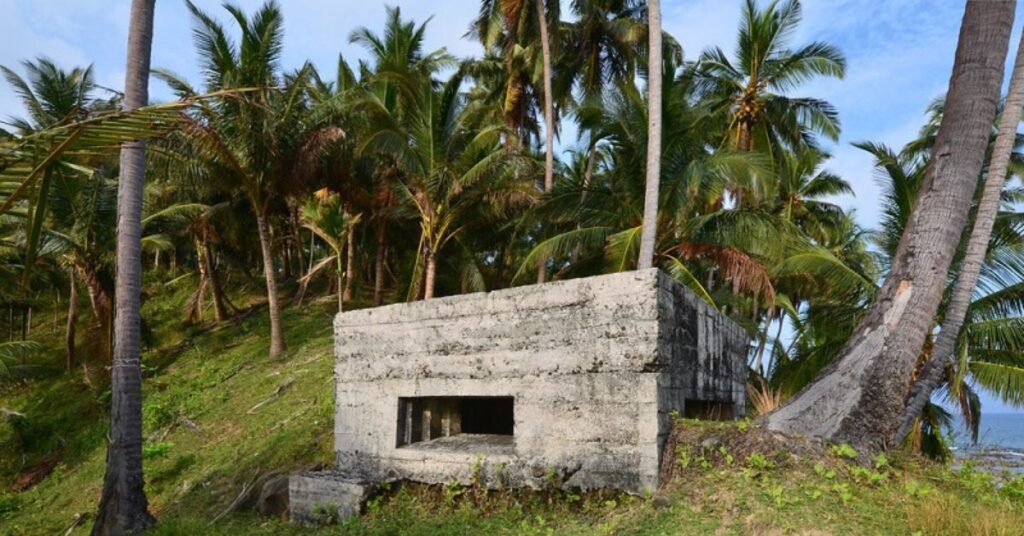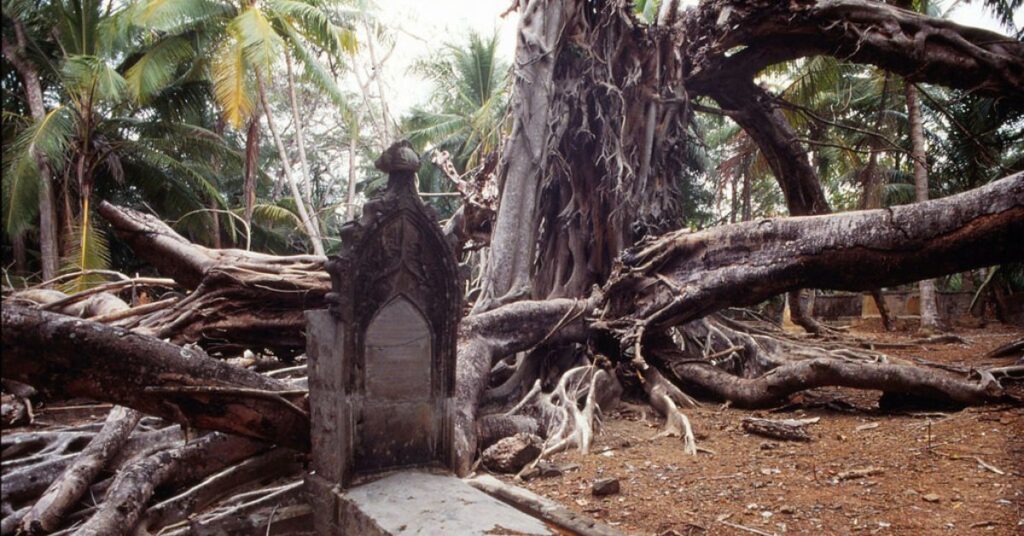Ross Island is a magical place where history meets nature. This beautiful island, once the boss of the British in the Andamans, is now a peaceful spot filled with old buildings and green plants. It’s like stepping back in time as you walk around the broken-down houses, old graveyards, and churches. But Ross Island isn’t just about the past. It’s also home to lots of friendly deer and colorful peacocks. A short boat ride from Port Blair, this island is perfect for people who love history and nature.
How to reach:
- By Air: The easiest way to reach Port Blair, the capital of the Andaman and Nicobar Islands, is by flying. Several airlines offer flights from major Indian cities to Port Blair’s Veer Savarkar International Airport.
- By Sea: For a slower-paced journey, passenger ships sail to Port Blair from cities like Chennai, Kolkata, and Visakhapatnam. These voyages take several days.
Reaching Ross Island from Port Blair
- By Ferry: The most common way to reach Ross Island is by ferry. Regular ferries depart from Aberdeen Jetty (Rajiv Gandhi Water Sports Complex) in Port Blair. The journey takes about 15-20 minutes.
- By Private Boat: For a more personalized experience, you can hire a private boat. This option offers more flexibility but is typically pricier.
Best time to visit:
Winter (October to February)
Winter is the most pleasant time to visit the Andaman and Nicobar Islands. Temperatures range from 20°C to 30°C, making it perfect for sightseeing and outdoor activities. You can also enjoy several local festivals during this period.
Summer (March to April)
Early summer is another good option. Temperatures rise to between 24°C and 35°C, but mornings and evenings remain comfortable. The calm sea is ideal for water sports like snorkeling and diving.
Monsoon (May to September)
The monsoon season brings heavy rain and strong winds to the Andaman and Nicobar Islands. Temperatures range from 24°C to 31°C. Travel can be disrupted due to heavy rain and rough seas. While the islands are lush and green, outdoor activities are limited.
AttraCtion:
British Colonial Ruins:

Ross Island is like a ghost town from the past. Once the boss of the British in the Andamans, it’s covered in the bones of old, fancy houses. The Commissioner’s house and the big boss’s house are the most famous. These old buildings are now covered in green plants, looking both beautiful and spooky. You can almost imagine important meetings happening in those big rooms, but now they’re just quiet and empty. It’s weird to see how nature is taking over these old buildings. Walking around, you really feel the history of the place and what life was like for the people who lived there.
Presbyterian Church:

The old Presbyterian Church on Ross Island is like a sad ghost story. Once a beautiful place for worship, it’s now just a broken shell covered in green plants. The big windows and fancy stonework are still there, but they’re falling apart. You can almost hear the singing and praying that happened here a long time ago. The broken seats and altar tell a story of a busy island and happy people. It’s a sad reminder that things don’t last forever, and it makes you think about the people who used to be there.
Japanese Bunkers:

The Japanese bunkers on Ross Island are a stark reminder of a different kind of history. Built during World War II, these dark, thick tunnels show how the island was used as a battlefield. Walking through them, you can feel the tough life of the soldiers and understand why the island was so important in the war. Overgrown and quiet now, these bunkers tell a story of strength and survival in a tough time.
Cemetery:

The British Cemetery on Ross Island is a quiet, sad place that tells a story of the past. It’s where many British people who lived and worked on the island are buried. The old tombstones with their sad messages tell stories of lives far from home. Walking around, you can feel how hard life was for these people. The cemetery is peaceful with green trees and quiet paths, and it makes you think about the past and the people who lived here.
Local Experiences:
Guided Tours: Learn about the island’s history from a knowledgeable guide.
Light and Sound Show: Immerse yourself in the island’s past through a dramatic evening show.
Photography: Capture the island’s beauty with your camera.
Birdwatching: Spot various bird species, including peacocks.
Wildlife Encounters: Interact with friendly deer and peacocks.
Picnic: Enjoy a relaxing meal surrounded by nature.
Explore Bunkers: Discover the island’s World War II history.
Visit the Museum: Learn more about Ross Island’s past through exhibits.
Take a Walk: Enjoy the island’s peaceful atmosphere.
Try Local Food: Savor the taste of Andamanese cuisine.
Water Activities: Enjoy snorkeling and other water sports nearby.
Watch the Sunset: End your day with a beautiful sunset view.
Travel tips:
- Ferry Schedule: Check the ferry timetable from Aberdeen Jetty in Port Blair to Ross Island. Ferry services operate multiple times daily, but schedules can change.
- Book in Advance: Reserve your ferry ticket, especially during peak season (December to January), to secure your spot.
- Best Time to Visit: Opt for the cooler months (October to February) for pleasant weather. Avoid the monsoon season (May to September) due to rain and rough seas.
- Pack Smart: Wear comfortable clothing and shoes. Bring a hat, sunglasses, and sunscreen to protect yourself from the sun. Stay hydrated by carrying water.
- Essentials: Bring cash as there are no ATMs on the island. Pack snacks, hand sanitizer, and a basic first-aid kit.
- Respect Nature: Avoid feeding wildlife and maintain a safe distance. Help preserve the island by not littering.
- Capture Memories: Bring a camera to capture the island’s beauty.
- Learn the History: Visit the Smritika Museum to deepen your understanding of Ross Island’s past.
- Savor Local Flavors: Enjoy Andamanese cuisine at eateries near Aberdeen Jetty.
- Respectful Exploration: Admire the historical ruins without touching or damaging them.
Conclusion
Ross Island, a captivating blend of history and nature, offers an unforgettable experience. Once a bustling British administrative hub, the island now stands as a poignant reminder of a bygone era, with its crumbling colonial structures and remnants of Japanese occupation. Lush greenery, vibrant wildlife, and serene surroundings complement the island’s historical allure. Immerse yourself in its past through guided tours and the captivating Light and Sound Show. For an enriching visit, respect the island’s environment and history. Ross Island is more than a destination; it’s a journey through time, a haven for nature lovers, and a place to create lasting memories. Follow Xplro for more.
FAQs
What is the significance of Ross Island?
- Ross Island is historically significant as it once served as the administrative center for the British in the Andaman and Nicobar Islands. The island features remnants of colonial buildings, Japanese military bunkers from World War II, and lush natural landscapes, making it a notable site for history and nature enthusiasts.
How can I reach Ross Island?
- To visit Ross Island, travel first to Port Blair, the capital of the Andaman and Nicobar Islands. From there, you can catch a ferry at Aberdeen Jetty, which will take you to Ross Island in approximately 15 to 20 minutes.
When is the ideal time to visit Ross Island?
- The optimal time to visit Ross Island is between October and April, when the weather is typically pleasant. The monsoon season, from May to September, brings heavy rainfall and can disrupt travel plans, making it less ideal for visiting.
Is there an entry fee for Ross Island?
- Yes, visiting Ross Island requires an entry fee. The amount varies for Indian and foreign visitors. It is recommended to verify the current fee details prior to your trip.
What should I wear for a visit to Ross Island?
- Dress in lightweight, breathable clothing and comfortable walking shoes, as the island’s climate can be warm and humid. Additionally, wearing a hat and sunglasses will help protect you from the sun.
Are there food options available on Ross Island?
- Food options on Ross Island are quite limited. It’s a good idea to bring your own snacks and water. You can find various local eateries near Aberdeen Jetty in Port Blair for a meal before or after your visit.
Can I engage in swimming or snorkeling around Ross Island?
- Ross Island itself is not primarily known for swimming or snorkeling. However, you can explore nearby locations that offer water activities if you are interested in these experiences.
Are guided tours offered on Ross Island?
- Yes, guided tours are available and can enrich your visit by providing comprehensive historical information and insights into the island’s past. These tours can be arranged through local operators in Port Blair.
What kinds of wildlife might I encounter on Ross Island?
- The island hosts a variety of wildlife, including deer, peacocks, and numerous bird species. The natural environment supports these animals, making it a pleasant spot for wildlife viewing.
Are there restrooms and other amenities on Ross Island?
- Ross Island has basic restroom facilities, though they may be limited. It’s advisable to use facilities in Port Blair before boarding the ferry and to carry essentials such as tissues and hand sanitizer.
How much time should I allocate for a visit to Ross Island?
- A typical visit to Ross Island lasts about 2 to 3 hours, which allows ample time to explore the historical ruins, visit the Smritika Museum, and enjoy the scenic beauty of the island.
Is Ross Island a good destination for children?
- Ross Island is suitable for children, offering educational experiences through its historical sites and natural surroundings. However, it’s important to keep an eye on children, particularly around the ruins and wildlife.






